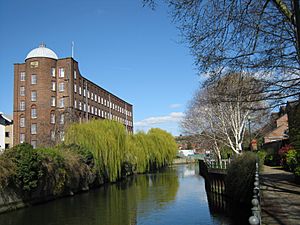St James Mill facts for kids
St James Mill is a historic building in Norwich, England. It was built during a time called the Industrial Revolution, when many new factories and machines were changing how things were made. This mill played an important part in Norwich's history, especially with its textile (fabric) industry.
Contents
What is St James Mill?
St James Mill is a large, old factory building located in the city of Norwich. It was constructed between 1836 and 1839. Today, it's no longer a factory but a modern office complex.
Why Was St James Mill Built?
The mill was originally built by a group called the Norwich Yarn Company. They started in 1833, and their main goal was to save the local textile trade. The textile trade was about making fabrics and clothes, and it was struggling at the time.
The company hoped that building this new, modern mill would help keep the fabric-making business strong in Norwich. A famous architect named John Brown designed the building.
A Site with Ancient Roots
Even before the mill was built, the land it stands on had a long history. In the 13th century (that's the 1200s!), a group of monks called the White Friars lived there. They were also known as the Carmelites.
Some parts of their old buildings still exist today. You can still see an original archway and an undercroft, which is like an underground room or cellar.
St James Mill's Changing History
Over the years, St James Mill has had many different owners and uses:
- Early 1900s: The local textile trade continued to decline, meaning fewer fabrics were being made. In 1902, a company called Jarrold & Sons Ltd bought the mill. They used it for their printing business.
- Chocolate and Training: Later, Jarrolds rented the building to Caley's, a company that made chocolate! Then, in 1920, the government bought the mill. They turned it into a training factory to help soldiers who had returned from war learn new skills.
- Back to Jarrolds: In 1933, Jarrolds bought the mill back again. Today, it's a private office complex. Different businesses and organizations have their offices there, like Virgin Wines and the Norfolk Community Foundation.
Part of Norwich's Heritage
St James Mill is also recognized as one of the Norwich 12. This is a special group of twelve important and historic buildings in Norwich. They represent the city's rich history and architecture, from medieval times to the Industrial Revolution.


